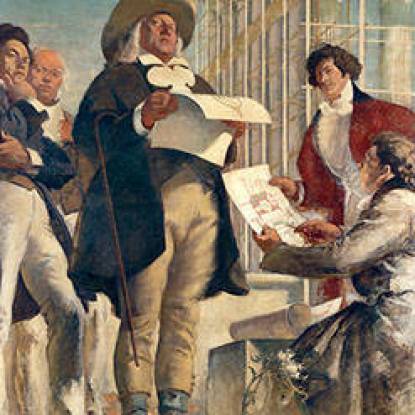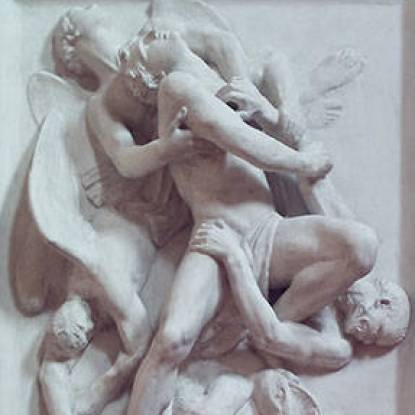Rustic Scene: Villagers Dancing
The Times claimed this large-scale work by the student artist and 'Bright Young Thing' heralded the revival of mural painting.
Whistler’s Mural
This is the first mural ever painted by Rex Whistler, an artist who led the revival of British mural painting in the 1920s and 30s. It was painted in the summer of 1924 when Whistler was a student at the Slade.
The revival of mural painting was a pet project of Henry Tonks (see The Four Founders), who was head of the Slade at the time. He saw potential in Whistler and Mary Adshead when they jointly won the Slade Summer Composition Competition in 1924. Tonks had inherited a small fund for the promotion of mural painting from his predecessor in the post and, with Whistler and Adshead in mind, went in search of a suitable location. Through Charles Aitken – who was then the Director of the Tate Gallery having formerly headed up the Whitechapel Gallery – he approached the Highway Club for Boys in Shadwell. They agreed and Tonks sent Whistler and Adshead to work there.
Whistler decided to paint a rustic idyll. The mural is a scene of Londoners enjoying themselves in a village on the edge of a heath. The foreground shows a man and woman dancing to music from a flute and a fiddle outside an inn. The surrounding landscape is true to life, including a duck pond, horse-drawn caravans and chickens pecking about the road.
The work is a blend of realism and fantasy and, notably, a departure from the crisp and precise style Whistler demonstrated in his early and later works. His approach here is bolder, more dynamic, and theatrical. It is interesting that in all subsequent murals – and he went on to be a renowned mural painter – he dropped this style in favour of sharp definition, detail and elaboration, none of which are evident here.
The work came to UCL in 1958 as a gift from Lady Ravensdale, who was then the Chairman of the Highway Club for Boys.
Rex Whistler
Rex Whistler (1905 – 1944) was an artist, designer and illustrator and one of the leading figures in British art in the first half of the 20th Century.
Whistler displayed a talent for imaginative and humorous drawing when still at school. He spent one term at the Royal Academy Schools, leaving when his tutors did not consider him talented enough to stay. Henry Tonks, then head of the Slade School of Fine Art accepted Whistler as a student, keen to make something of his talent in order to score a point against the rival school.
Whistler won many prizes at the Slade including 2nd prize for figure painting in 1923, 1st prize for figure painting in 1924 and joint 2nd prize in the same year for the Summer Composition Competition with Mary Adshead. As a result of this success Tonks arranged for Whistler and Adshead to produce a series of murals – including this one – for the Highways Boys Club in Shadwell. Whistler’s talent dominated the Slade to such an extent that a fellow student painted a cartoon for the Christmas dance showing Tonks crowning Whistler with laurels.
On leaving the Slade, Whistler went on to a hugely successful career in art and design, starting with a commission to paint murals for the Tate Gallery restaurant . His later career was divided between mural and trompe l’oeil commissions, book illustrations and theatre set design, and he was a key figure in the revival of mural art in the 1920s and 30s.
When WWII broke out, Whistler enlisted with the Welsh Guards. He continued to draw and paint throughout the war; one famous story describes how he kept a bucket full of paintbrushes hung along the side of his tank. Whistler was posted to France following the D-Day landings. He was among the first British losses of the Normandy campaigns.
 Close
Close




